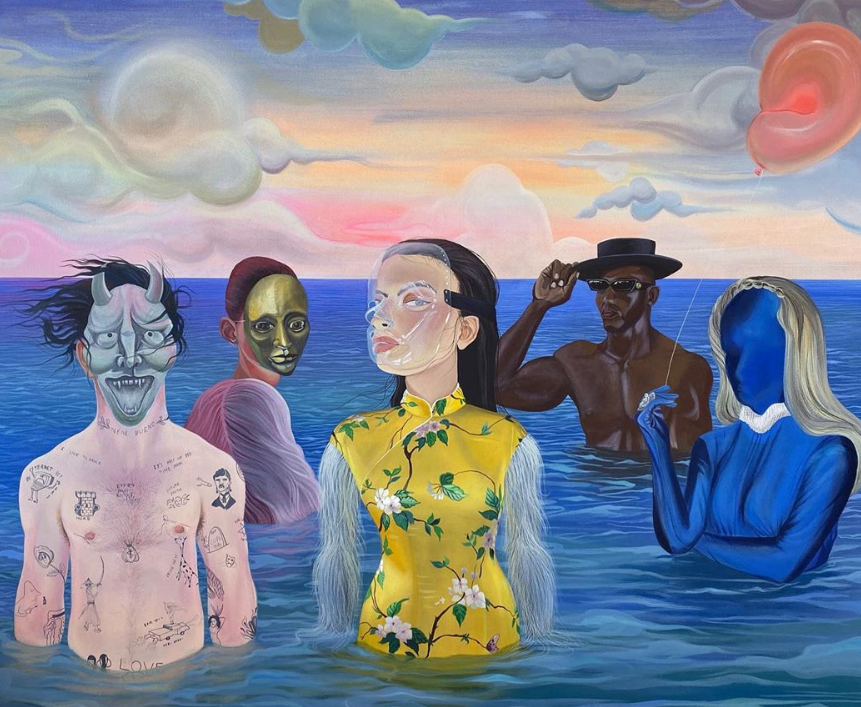Rounding up Art Basel 2019 | At least 4 Caribbean Artists you need to know now
Rounding up 2019, Art Basel included a range of shows in Overtown, Little Haiti and North Miami, among other places, spotlighting Latin American and Caribbean influences. Such artists are recognized as major contributors to the fabric of of Miami’s diverse artistic community. Of these multicultural gems, we at Les Iles have been particularly struck by the works of the following artists, who we believe that everyone should know:
- Zoya Taylor

Zoya Taylor was born in Vancouver, raised in Kingston, is now a resident of Oslo, Norway. In a personal statement about her work, she says:
“My art falls somewhat outside, but I guess that is only fitting. I paint the cast of characters which fill the spaces in between. We all have a cast of characters that define our lives. My cast is the cast of the misfit. They are “immigrants” found between cultures, continents, languages and disciplines. My characters become their own characters and in this way hopefully the characters of their viewers ”.
The theme of immigration is heavily impressed, since “she now feels herself to be both of many places and no place at all.” She focuses on people themselves, expressing her fascination with them and the varying themes of humanness. She hopes to extract through her work, an emotional connection, which recognizes secrecy, pride and hurt, but also humor, hope and love.
2. Dalton Gata Garcia


Dalton Gata Garcia was born in Santiago de Cuba, Cuba and now lives and work in Coamo, Puerto Rico.
Art Basel shared an image of Garcia’s ‘Swimming On Asphalt, While Dreaming Of The Sea’ on their social media, describing it as “a glimpse into the artist’s universe; one that blends his personal identity with popular Caribbean culture and autobiographical references. Mixing personal relationships with past lovers and Internet findings, music with fashion and design, and blending drag with fantastical creatures and scenarios.”
The artist intimately investigates identity and memory, and addresses different angles around the concept of how we become who we are. Within the context of Caribbean art specifically, his undaunted depictions of gender diversity are striking, since they address a traditionally taboo subject matter without much obscurity.
3. Suchitra Mattai

Suchitra Mattai was born in Guyana, but has spent her life in a diverse mix of locations all over the world. She has spent time in Halifax and Wolfville, Nova Scotia, Philadelphia, New York City, Minneapolis, and Udaipur, India. These varied environments have directly impacted her research and influence.
Suchitra is a multi-disciplinary artist who now lives and works in Denver, Colorado. In her statement, she explains that her primary interests are the complex relationship between the natural and artificial worlds, and the questioning of historical and authoritative narratives, especially those surrounding colonialism. She creates via a wide range of materials, incorporating textiles, embroidery, painting, fiber, drawing, collage, installation, video, and sculpture. “The other” is a common theme in her message, with particular consideration paid to the Indian diaspora, especially as it relates to Caribbean immigration and indentureship.
4. Paul Anthony Smith

The Jamaican-born, Brooklyn-based artist Paul Anthony Smith employs picotage in his photographic work, adapting a technique traditionally used for printed textiles. With a ceramic tool resembling a needle, he laboriously picks away small dots from the surface of his pigment prints to create shapes that tend to look like breeze block wall patterns, or chain-link fences.
He references both W.E.B. Du Bois’ concept of double consciousness and Franz Fanon’s theory of diasporic cultural confusions caused by colonialism. The photographs are captured in Jamaica and New York, and are of Afro Caribbean subjects. However, he alludes to African rituals of scarification to obscure and alter his subjects’ faces and skin. His work questions the ability of a photograph to retain the truth in its storytelling.
